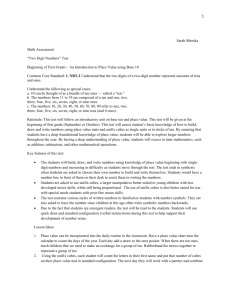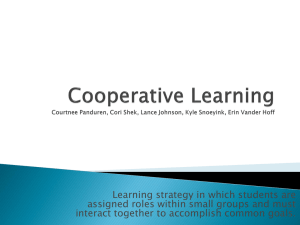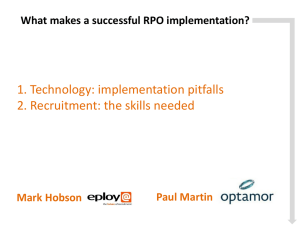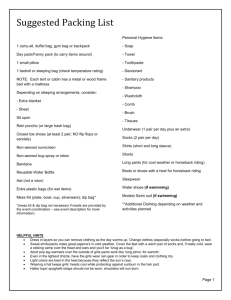Materials List
advertisement
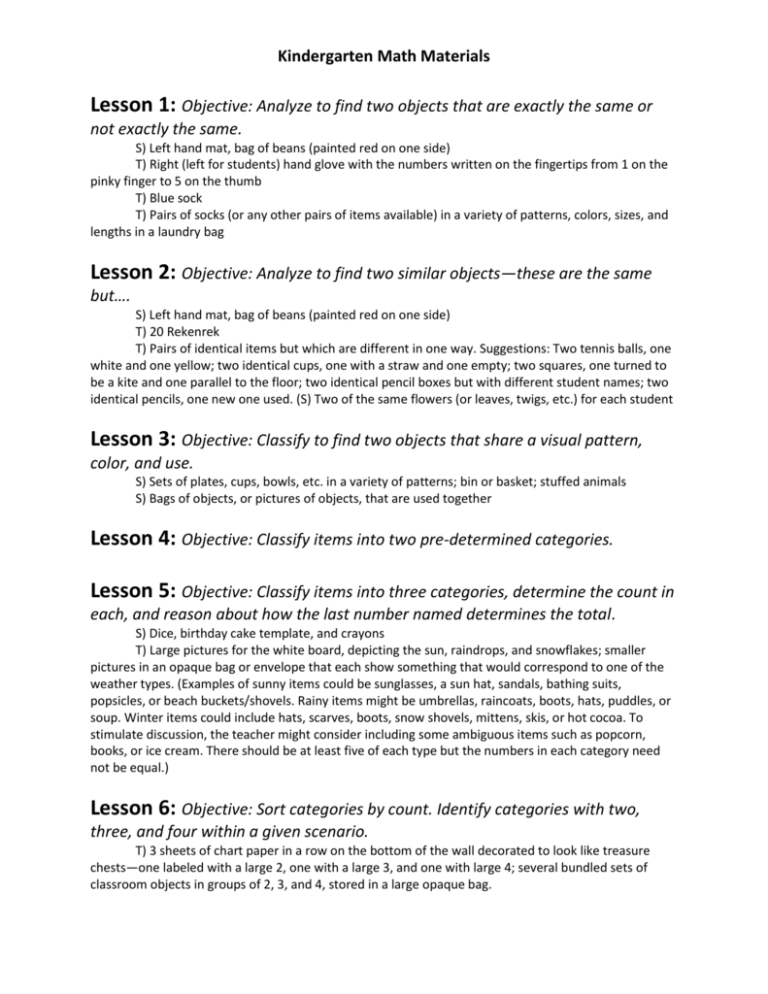
Kindergarten Math Materials Lesson 1: Objective: Analyze to find two objects that are exactly the same or not exactly the same. S) Left hand mat, bag of beans (painted red on one side) T) Right (left for students) hand glove with the numbers written on the fingertips from 1 on the pinky finger to 5 on the thumb T) Blue sock T) Pairs of socks (or any other pairs of items available) in a variety of patterns, colors, sizes, and lengths in a laundry bag Lesson 2: Objective: Analyze to find two similar objects—these are the same but…. S) Left hand mat, bag of beans (painted red on one side) T) 20 Rekenrek T) Pairs of identical items but which are different in one way. Suggestions: Two tennis balls, one white and one yellow; two identical cups, one with a straw and one empty; two squares, one turned to be a kite and one parallel to the floor; two identical pencil boxes but with different student names; two identical pencils, one new one used. (S) Two of the same flowers (or leaves, twigs, etc.) for each student Lesson 3: Objective: Classify to find two objects that share a visual pattern, color, and use. S) Sets of plates, cups, bowls, etc. in a variety of patterns; bin or basket; stuffed animals S) Bags of objects, or pictures of objects, that are used together Lesson 4: Objective: Classify items into two pre-determined categories. Lesson 5: Objective: Classify items into three categories, determine the count in each, and reason about how the last number named determines the total. S) Dice, birthday cake template, and crayons T) Large pictures for the white board, depicting the sun, raindrops, and snowflakes; smaller pictures in an opaque bag or envelope that each show something that would correspond to one of the weather types. (Examples of sunny items could be sunglasses, a sun hat, sandals, bathing suits, popsicles, or beach buckets/shovels. Rainy items might be umbrellas, raincoats, boots, hats, puddles, or soup. Winter items could include hats, scarves, boots, snow shovels, mittens, skis, or hot cocoa. To stimulate discussion, the teacher might consider including some ambiguous items such as popcorn, books, or ice cream. There should be at least five of each type but the numbers in each category need not be equal.) Lesson 6: Objective: Sort categories by count. Identify categories with two, three, and four within a given scenario. T) 3 sheets of chart paper in a row on the bottom of the wall decorated to look like treasure chests—one labeled with a large 2, one with a large 3, and one with large 4; several bundled sets of classroom objects in groups of 2, 3, and 4, stored in a large opaque bag. Kindergarten Math Materials Lesson 7: Objective: Sort by count in vertical columns and horizontal rows (linear configurations to 5). Match to numerals on cards. S) Blank five frame, bags of 5 cubes, dice (with 6 dot side covered) T) 20 Rekenrek S) Bag of linking cubes (5 different colors so that each color contains different quantities to 5: 1 blue, 2 red, 3 yellow, 4 green, and 5 brown) and digit cards to 5 per student Lesson 8: Objective: Answer how many questions to 5 in linear configurations (5-group) with 4 in an array configuration. Compare ways to count 5 fingers. T) 5-group cards S) Counters in a bag T) 5 markers S) Bag with 5 cotton balls S) Personal white boards Lesson 9: Objective: Within linear and array dot configuration of numbers 3, 4, and 5 find hidden partners. T) 5-group cards S) Dice with the 6 dot side replaced with 0 (by covering with a piece of mailing label), numeral cards S) Two linking cube sticks of 5, Hidden Partners template for each pair of students Lesson 10: Objective: Within circular and scattered dot configurations of numbers 3, 4, and 5 find hidden partners. S) Bag of beans, piece of construction paper or foam to be used as a work mat, small plastic cup T) Large 5-frame cards T/S) 5 counting bears—1 large red, 2 large yellow, 2 small yellow; 1 paper clip Lesson 11: Objective: Model decompositions of 3 with materials, drawings, and expressions. Represent the decomposition as 1 + 2 and 2 + 1. S) 3 beans, paper or foam triangle S) 3 linking cubes T/S) 5 counting bears or linking cubes for each pair of students, 1 blue paper, 1 green paper, digit cards to 5 Lesson 12: Objective: Understand the meaning of zero. Write the numeral 0. S) Bag of 5 loose linking cubes per student (varied colors), personal white board Kindergarten Math Materials Lesson 13: Objective: Order and write numerals 0–3 to answer how many questions. T) Cardboard picture frame (S) Personal white boards prepared with numeral writing insert T) 3 identical objects Lesson 14: Objective: Write numerals 1–3. Represent decompositions with materials, drawings, and equations, 3 = 2 + 1 and 3 = 1 + 2. S) 3 beans, paper or foam triangle S) 3 beans, paper or foam triangle S) Bags of 3 linking cubes (loose, not stacked) Lesson 15: Objective: Order and write numerals 4 and 5 to answer how many questions in categories; sort by count. T) Personal white board (S) Number path S) Birthday cake number order cards S) Personal white boards T) Personal white board or chart paper and sticky notes; cardboard picture frame for writing (S) Personal white board with numeral writing insert Lesson 16: Objective: Write numerals 1–5 in order. Answer and make drawings of decompositions with totals of 4 and 5 without equations. S) 4 beans, paper or foam squares S) Birthday cake number order cards for each pair of students T) Personal white board and five magnetic shapes or pictures (divided by a line down the middle) (S) Digit cards 1–5 (1 set per student), shuffled; bag of 5 loose linking cubes per student Lesson 17: Objective: Count 4–6 objects in vertical and horizontal linear configurations and array (i.e., 3 and 3, 3 twos) configurations. Match 6 objects to the numeral 6. T) Large 5-group cards S) Bag of 6 loose linking cubes, beans or other counters; work mat; set of number cards 1–6; two 5-group mat for each student Lesson 18: Objective: Count 4–6 objects in circular and scattered configurations. Count 6 items out of a larger set. Write numerals 1–6 in order. T) Cardboard writing frame on whiteboard (S) 1 small clear plastic bag of 10 lima beans or small counters, 1 work mat, inscribed with a large circle, 1 plastic cup Kindergarten Math Materials Lesson 19: Objective: Count 5─7 linking cubes in linear configurations. Match with numeral 7. Count on fingers from 1 to 7 and connect to 5-group images. T) Large ten-frame cards S) A two-hands mat, bags containing 5 red painted beans, 5 white beans T) Writing frame on the white board, classroom size 5-group mats to show numbers through 7 S) 1 bag of 10 loose linking cubes (5 each of red and blue), 5-group mat, set of digit cards 1–7 Lesson 20: Objective: Reason about sets of 7 varied objects in circular and scattered configurations. Find a path through the scattered configuration. Write numeral 7. Ask, “How is your seven different than mine?” S) 3 beans, paper or foam triangle, personal white boards S) Two-hands mat, bag of beans (painted red on one side) T) Cardboard writing frame on white board (S) Bag of 10 counters (objects should vary from student to student), work inscribed with a large circle, plastic cup, personal white board Lesson 21: Objective: Compare counts of 8 in linear and array configurations. Match with numeral 8. T) Linking cubes, cardboard writing frame on the whiteboard, classroom size 5-group mats to show numbers through 8 (S) Bag of 10 loose linking cubes, 5 blue and 5 red, work mat, two 5-group mats, set of digit cards 1–8 Lesson 22: Objective: Arrange and strategize to count 8 beans in circular (around a cup) and scattered configurations. Write numeral 8. Find a path through the scatter set and compare paths with a partner. S) 4 beans, paper or foam squares, personal white boards T) Large 5-group cards T) Cardboard writing frame on white board (S) Bag of 10 beans or other small counters (objects should vary from student to student), work mat, plastic cup, personal white board Lesson 23: Objective: Organize and count 9 varied geometric objects in linear and array (3 threes) configurations. Place counts on 5-group dot mat. Match with numeral 9. T) Cardboard writing frame on whiteboard (S) 1 bucket of assorted pattern blocks, 5-group dot mat, set of number cards 1–9 Lesson 24: Objective: Strategize to count 9 objects in circular (around a paper plate) and scattered configurations printed on paper. Write numeral 9. Represent a path through the scatter count with pencil. Number each object. S) 5 linking cubes, personal white boards T) Cardboard writing frame on whiteboard (S) Bag of 10 small counters (objects should vary from student to student), plastic cup and small paper plate, personal white board Kindergarten Math Materials Lesson 25: Objective: Count 10 objects in linear and array configurations (5 and 5). Match with numeral 10. Place on the 5-group dot mat. Dialogue about 9 and 10 on the mat. Write numeral 10. S) Personal white boards, blank 5-group insert T) Cardboard writing frame on whiteboard (S) Bag of 10 beans, bag of 10 linking cubes (5 red and 5 blue), construction paper work mat, 5-group dot mat, number cards 1–10 Lesson 26: Objective: Count 10 objects in linear and array configurations (5 and 5). Match with numeral 10. Place on the 5-group dot mat. Dialogue about 9 and 10 on the mat. Write numeral 10. S) Personal white boards T) Cardboard writing frame on white board (S) Bag of 5 red and 5 white pony beads, pipe cleaner or lanyard for bracelet, 5-group dot mat, personal white board Lesson 27: Objective: Count 10 objects and move between all configurations. S) Bag of 10 small counters (objects should vary from student to student), 5-group dot mat, work mat inscribed with a large circle, plastic cup Lesson 28: Objective: Act out result unknown story problems without equations. S) Bags of red and white beans, construction paper work mat, dice T) 10 sheets of construction paper, each labeled with a large number (1–10), placed in a row on the floor in the front of the room to make a “number path,” set of number cards (1–10) (S) Bag of 20 loose linking cubes (10 red and 10 white) Lesson 29: Objective: Order and match numeral and dot cards from 1 to 10. State 1 more than a given number. S) Pennies, number path T) Magnets or brown circles of paper to represent pennies S) Bag of pennies, piggy bank mat S) One set of 5-group cards for each student Lesson 30: Objective: Exploration: Make math stairs from 1 to 10 in cooperative groups. S) Numeral cards 1–10 S) Bag of red and white beans, hands mat S) Bag of 30 loose red linking cubes, bag of 25 loose blue linking cubes Kindergarten Math Materials Lesson 31: Objective: Arrange, analyze, and draw 1 more up to 10 in configurations other than towers. S) Dice, paper and pencil or personal white boards S) Large construction paper work mat (21” x 24”) per 2 students inscribed as below (circles should have a diameter of at least 4”), set of linking cube stairs from yesterday, red and blue crayon Lesson 32: Objective: Arrange, analyze, and draw sequences of quantities of 1 more, beginning with numbers other than 1. S) Fluency Problem Set T) Set of linking cube number stairs from 1 to 10 (S) 10 index cards, crayons Lesson 33: Objective: Order quantities from 10 to 1 and match numerals. S) Bags of beans, laminated paper or foam work mat, dice T) Large digit cards 1–10 or a number path written on the board (S) Bag of 5 blue and 5 red loose linking cubes, 5-group dot mat, 5-group cards 1–10 Lesson 34: Objective: Count down from 10 to 1 and state 1 less than a given number. T) A large tree drawn on the whiteboard, 10 cardboard apples affixed to the tree with tape in a circular formation, a simple puppet made from a paper bag to represent a farmer (S) 5-group cards (1– 10) Lesson 35: Objective: Arrange number towers in order from 10 to 1 and describe the pattern. S) Bag of red and white beans, hands mat Lesson 36: Objective: Arrange, analyze, and draw sequences of quantities that are 1 less in configurations other than towers. S) Fluency Problem Set from Lesson 32 S) Dice S) Large construction paper work mat (24” x 21”) for each two students, inscribed as above (circles should have a diameter of at least 4”); set of linking cube stairs from yesterday; red and blue crayons Lesson 37: Objective: Culminating task—(Materials for this task include 5group cards from 0–10). “Decide how to classify the objects in your bag into two groups. Count the number of objects in each group. Represent the greater number in various ways. Next, remove the card from your pack that shows the number of objects in the smaller Kindergarten Math Materials group. Put your remaining cards in order from smallest to greatest. Your friends will have to figure out what card is missing when they visit your station!” S) 10 linking cubes per student S) 10 paper “mystery” bags, each containing a set of loose linking cubes such that the first bag has 1, the second, 2, and so on up to 10; materials for each station: 1 set of 5-group cards, pipe cleaner and bag with 5 red and 5 white beads, 1 bag of 10 lima beans, 1 bag of 10 popsicle sticks, 2 bags of other various counters (10 each), personal white board and markers, Rekenrek, 2 work mats inscribed with a large circle, 2 5-group mats, paper plate, plastic cup, crayons and paper, other materials as desired Assessments Topic A: Attributes of Two Related Objects : S) Module 1 Assessment Picture Cards, cut out Topic B: Classify to Make Categories and Count: S) Module 1 Assessment Picture Cards, cut out; sorting mat Topic C: Numerals to 5 with Different Configurations, Math Drawings, and Expressions: S) 10 linking cubes Topic D: The Concept of Zero and Working with Numbers 0–5: S) Sort from Topic B (please remove one identical bear for this assessment task so that you have 5 toys and 3 school items), numeral writing sheet Topic E: Working with Numbers 6–8 in Different Configurations: S) 10 linking cubes (or other familiar classroom object), numeral cards 0–10 Topic F: Working with Numbers 9–10 in Different Configurations: S) 12 linking cubes (or other familiar classroom object), “woods” template Topic G: One More Than with Numbers 0–10: T) Numeral cards 7, 8, and 9; dot card showing 4 dots; 10 cubes Topic H: One Less Than with Numbers 0–10: T) Numeral and 5-group cards 1–10; 10 counting objects


